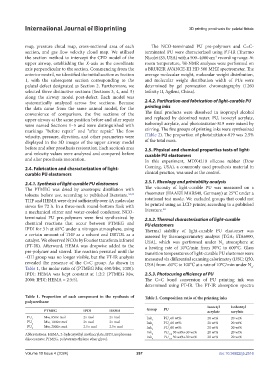Page 275 - IJB-10-4
P. 275
International Journal of Bioprinting 3D printing prosthesis for palatal fistula
map, pressure cloud map, cross-sectional area of each The NCO-terminated PU pre-polymers and C=C-
section, and gas flow velocity cloud map. We utilized terminated PU were characterized using FT-IR (Thermo
the section method to intercept the CFD model of the Nicolet iS5, USA) with a 500–4000 cm recording range. At
-1
upper airway, establishing the X-axis as the coordinate room temperature, H-NMR analyses were performed on
1
axis perpendicular to the section. Commencing from the a BRUKER AVANCE-III HD 500 MHZ spectrometer. The
anterior nostril, we identified the initial section as Section average molecular weight, molecular weight distribution,
1, with the subsequent section corresponding to the and molecular weight distribution width of PUs were
palatal defect designated as Section 2. Furthermore, we determined by gel permeation chromatography (1260
selected three distinctive sections (Sections 3, 4, and 5) Infinity II, Agilent, China).
along the airway model post-defect. Each model was
systematically analyzed across five sections. Because 2.4.2. Purification and fabrication of light-curable PU
the data came from the same animal model, for the printing inks
convenience of comparison, the five sections of the The final products were dissolved in isopropyl alcohol
upper airway at the same position before and after repair and replaced by deionized water. PU, isooctyl acrylate,
were named Sections 1–5 and were distinguished with isobornyl acrylate, and photoinitiator-819 were mixed by
markings “before repair” and “after repair.” The flow stirring. The five groups of printing inks were synthesized
velocity, pressure, direction, and other parameters were (Table 2). The proportion of photoinitiator-819 was 2.5%
displayed in the 3D images of the upper airway model of the total mass.
before and after prosthesis restoration. Each section’s area 2.5. Physical and chemical properties tests of light-
and velocity values were analyzed and compared before curable PU elastomers
and after prosthesis restoration. In this experiment, MDX4210 silicone rubber (Dow
2.4. Fabrication and characterization of light- Corning, USA), a commonly used prosthesis material in
curable PU elastomers clinical practice, was used as the control.
2.4.1. Synthesis of light-curable PU elastomers 2.5.1. Rheology and printability analysis
The PTMEG was dried by azeotropic distillation with The viscosity of light-curable PU was measured on a
toluene before use, according to published literature. 32,33 rheometer (HAAKE MARS40, Germany) at 25°C under a
THF and HEMA were dried sufficiently over 4A molecular rotational test mode. We excluded groups that could not
sieves for 72 h. In a three-neck round-bottom flask with be printed using an LCD printer, according to a published
34
a mechanical stirrer and water-cooled condenser, NCO- literature.
terminated PU pre-polymers were first synthesized by 2.5.2. Thermal characterization of light-curable
chemical reactions that occur between PTMEG and PU elastomers
IPDI for 3 h at 68°C under a nitrogen atmosphere, using Thermal stability of light-curable PU elastomer was
a certain amount of THF as a solvent and DBTDL as a assessed by thermogravimetry analysis (TGA; STA6000,
catalyst. We observed NCOs by Fourier transform infrared USA), which was performed under N atmosphere at
2
(FT-IR). Afterward, HEMA was dropwise added to the a heating rate of 10°C/min from 30°C to 600°C. Glass
pre-polymer and stirred. The reaction persisted until the transition temperatures of light-curable PU elastomer were
-OH group was no longer visible, but the FT-IR analysis measured via differential scanning calorimetry (DSC; Q50,
revealed the presence of the C=C group. As shown in USA) from -60°C to 100℃ at a rate of 10°C/min under N .
Table 1, the molar ratio of (PTMEG Mw, 650/Mw, 1000): 2
IPDI: HEMA was kept constant at 1:2:2 (PTMEG Mw, 2.5.3. Photocuring efficiency of PU
2000: IPDI: HEMA = 2:5:5). The C=C bond conversion of PU printing ink was
determined using FT-IR. The FT-IR absorption spectra
Table 1. Proportion of each component in the synthesis of Table 2. Composition ratio of the printing inks
polyurethane
Isooctyl Isobornyl
PTMEG IPDI HEMA Group PU acrylate acrylate
PU 1 Mw, 650× mol 2× mol 2× mol Ink PU 60 wt% 20 wt% 20 wt%
1
PU 2 Mw, 1000× mol 2× mol 2× mol Ink 1 PU 60 wt% 20 wt% 20 wt%
2
PU 3 Mw, 2000× mol 2.5× mol 2.5× mol Ink 2 3 PU 60 wt% 20 wt% 20 wt%
3
Abbreviations: HEMA, 2-hydroxyethyl methacrylate; IPDI, isophorone Ink 4 PU 30 wt%+30 wt% 20 wt% 20 wt%
1+2
diisocyanate; PTMEG, polytetramethylene ether glycol. Ink 5 PU 30 wt%+30 wt% 20 wt% 20 wt%
1+3
Volume 10 Issue 4 (2024) 267 doi: 10.36922/ijb.2516

